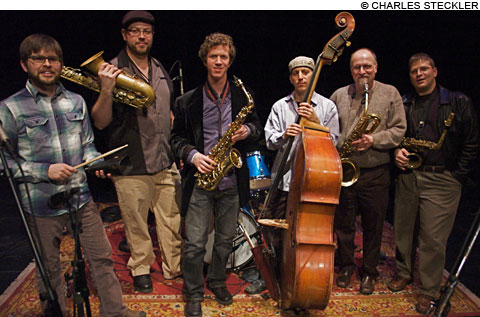
STORYTELLERS The new disc from Dead Cat Bounce comes with narratives — but you’re also welcome to make up your own. |
It's never easy to say what a piece of instrumental music "means." So composers give us titles and program notes and, when they get desperate, lyrics. Chance Episodes (Cuneiform), the new album from the sextet Dead Cat Bounce, comes with portentous liner notes from composer/bandleader Matt Steckler about the CD's thematic content — "memory's haphazard way of bringing to the fore seemingly unrelated events." In other words, "by chance." Some pieces come from personal experiences — either Steckler's, or the band's as a group. Others suggest "ruminations on the fate of the world from a personal perspective."But let's just say, for argument's sake, that Chance Episodes is about collective improv, the blues, about saxophones and flutes, bass and drums. And yes, the narrative of musical form. This is music that drives and sings and shouts — grooving hard one minute, pausing for free-time reveries the next. It might come together in the voices of four horns exulting as one, or a single voice testifying as a chorus gathers around it, moaning or hollering in assent. It's music that Bostonians first began hearing in 1999, when NEC grad Steckler began playing out with the band, with their particular blend of Mingus's bluesy, extended, "episodic" structures, and the massed counterpoint of the World Saxophone Quartet.
Steckler has been living in New York for several years now — teaching, working on a PhD in composition at NYU. But he's never given up writing for — or playing with — this band, who come to Ryles next Tuesday. Whatever the sources of the music, it brings about high emotions and alternately ferocious and lyrical playing. Listen to the way Jared Sims's tenor sax tears into the groove on album opener "Food Blogger," or Charlie Kohlhase's free-flowing ruminations over high reeds (almost like flutes) on "Madame Bonsilene." Steckler has become particularly adept at timbral colors, especially when he writes for flutes. The controlled chamber-group dissonances of "Madame Bonsilene" suggests classical procedures, but with a bit of grit in the grooves. And aside from the more "abstract" references, there are simpler pleasures here too. "Silent Movie, Russia 1995" has a lovely minor-key folk melody for Sims's clarinet, and a bit of oom-pah in its klezmer-like journey. And "Township Jive Revisited" suggests the joyful South African funk of bands like Ladysmith Black Mambazo with maybe a bit of jazz master Abdullah Ibrahim thrown in.
"I'm not a purist in any of this stuff," Steckler tells me on the phone from New York with a chuckle. "People know that by now."
The programmatic framework of the album can partly be explained by the CD's source in a commission from Chamber Music America. A thematic narrative, after all, tends to sound better in a grant proposal than a "pure" musical scheme.
Not that Steckler isn't sincere. "Even though it was a commission, and I gave it a title and there's a theme that ties everything together, I had to go a little bit into the composing process before I knew what it was about. I don't want to speak for all composers, but I guess I'm not the only one who works that way." But why not? Ask the composers of "Nostalgia in Times Square," "Skating in Central Park," or, hell, even Symphonie fantastique what came first, music or narrative.